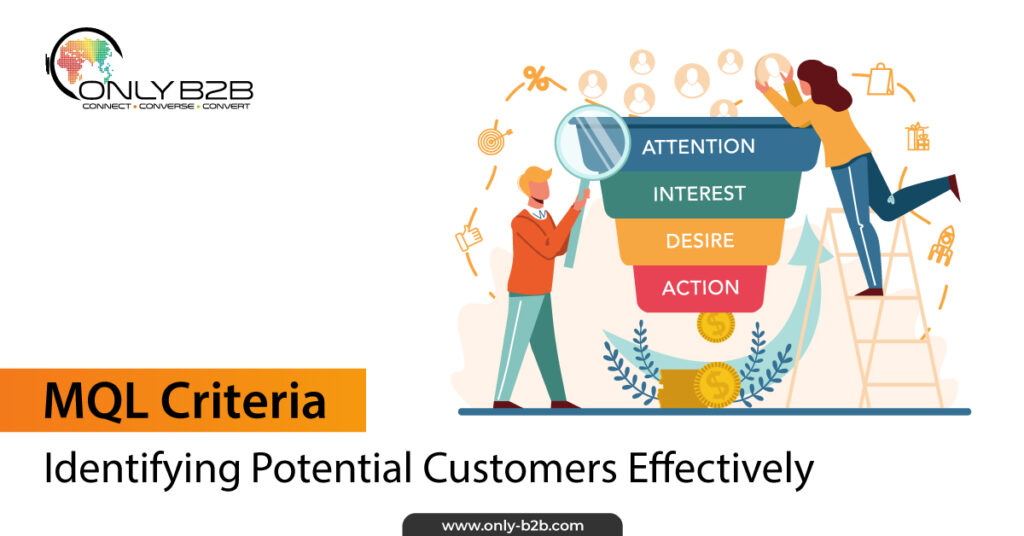
In the world of marketing and sales, it’s really important to find potential customers in a smart way. This means sifting through lots of leads and focusing on the ones that are most likely to become valuable customers. A super important tool for doing this is called Marketing Qualified Lead (MQL) criteria.
This blog looks into what MQL criteria are and how they help us find potential customers that matter.
Must Read: MQL to SQL Conversion Rate
Marketing Qualified Lead (MQL) Criteria: Identifying Potential Customers Effectively
Table of Contents

Potential clients who have expressed interest in your goods or services but haven’t quite developed to the point of being prepared for direct sales contact are known as marketing qualified leads (MQLs).
MQL criteria are the set of attributes, behaviors, and characteristics that determine whether a lead qualifies for MQL lead generation. These act as checkpoints that assist your marketing and sales teams in determining when a lead is sufficiently warmed up to engage in a fruitful sales conversation.
Must Read: Inbound vs. Outbound Lead Generation: Finding the Right Mix for MQLs
Key Components of Effective MQL Criteria
Demographic Information:
This includes basic details like industry, company size, job title, and location. By aligning leads’ demographics with your ideal customer profile, you increase the chances of targeting individuals who are more likely to find value in your offering.
Engagement Level:
Tracking how leads engage with your content, such as visiting your website, downloading resources, or interacting with your emails, helps gauge their level of interest. Higher engagement often indicates a stronger likelihood of conversion.
Behavioral Signals:
Monitoring specific behaviors, like attending webinars, requesting demos, or signing up for newsletters, can provide insights into a lead’s intent and interest.
Interaction History:
Understanding the historical interactions, a lead has had with your brand gives context to their journey. This could include past purchases, conversations with your team, or previous engagement.
Timing and Frequency:
Analyzing the frequency and recency of a lead’s interactions can indicate their current interest level. A lead who has engaged frequently in a short span might be closer to making a decision.
Budget and Authority:
Evaluating a lead’s budget allocation for the kind of solution you provide and their decision-making authority within the organization can help identify leads that are more likely to convert.
Challenges and Pain Points:
Leads expressing challenges or pain points that align with your solution’s benefits are strong indicators of potential customers. This shows that your offering addresses their needs.
Must Read: How to Leverage Account-Based Marketing (ABM) for Marketing Qualified Leads
Best Practices for Implementing MQL Criteria
Collaboration between Marketing and Sales:
Developing marketing qualified lead criteria should be a collaborative effort between marketing and sales teams. Both sides bring unique perspectives that ensure the criteria are comprehensive and aligned with sales goals, and ultimately contribute to a high lead-to-MQL conversion rate.
Regular Review:
The effectiveness of MQL criteria should be evaluated regularly. As market dynamics change and your understanding of customer behaviors deepens, your criteria might need adjustments.
Data-Driven Approach:
Base your MQL criteria on data and analytics. Look at historical conversion rates, customer journey patterns, and engagement metrics to inform your criteria.
Clear Communication:
Ensure everyone in your organization understands the MQL criteria. This prevents misalignment and helps maintain a unified focus on pursuing the right leads.
Must Read: Important Ways To Generate Marketing Qualified Leads
Marketing Qualified Leads Criteria
MQL criteria can be segmented into two broad categories: explicit and implicit criteria.
Explicit Criteria:
These are objective and directly observable attributes, like job title, industry, company size, and location. Explicit criteria are often demographic in nature and can be easily gathered from forms and interactions.
Implicit Criteria:
These are derived from the lead’s behavior and engagement. Examples include downloading resources, attending webinars, and visiting pricing pages. Implicit criteria provide insights into a lead’s intent and interest.
Must Read: Top Reasons to Hold On to MQLs: They Will Convert Eventually If Marketing Is Done Correctly
Defining MQL Parameters
Defining MQL parameters involves setting specific thresholds for each criterion, distinguishing Marketing Qualified Leads (MQLs) from Highly Qualified Leads (HQLs).
For instance, a lead might need to have visited your website at least three times in the last two weeks, downloaded an e-book, and shown interest in your pricing page to meet the MQL threshold. HQLs may exhibit even stronger engagement signals, such as requesting a demo or contacting sales directly
It’s important to note that MQL criteria are not universal; they vary depending on your industry, target audience, and the nature of your product or service. The key is to strike a balance between setting criteria that are stringent enough to indicate genuine interest but not so strict that potential leads are prematurely disqualified.
Must Read: Utilizing Intelligent Content Syndication To Produce High Intent MQLs
Conclusion
In the world of marketing and sales, MQL criteria act like a compass, showing us the way to potential customers almost ready to become loyal buyers.
By learning about MQL and adapting it to your business, you can find and nurture marketing qualified leads that are likely to become great customers.
Remember, MQL is a crucial stage in the sales funnel, distinct from Sales Qualified Leads (SQLs). MQLs show promise, but may need further nurturing before they’re ready for a sales conversation. Just remember, MQL isn’t fixed; it changes as your business does. Using MQL smartly helps you manage leads better and turn more leads into happy customers.

Vikas Bhatt is the Co-Founder of ONLY B2B, a premium B2B lead generation company that specializes in helping businesses achieve their growth objectives through targeted marketing & sales campaigns. With 10+ years of experience in the industry, Vikas has a deep understanding of the challenges faced by businesses today and has developed a unique approach to lead generation that has helped clients across a range of industries around the globe. As a thought leader in the B2B marketing community, ONLY B2B specializes in demand generation, content syndication, database services and more.


